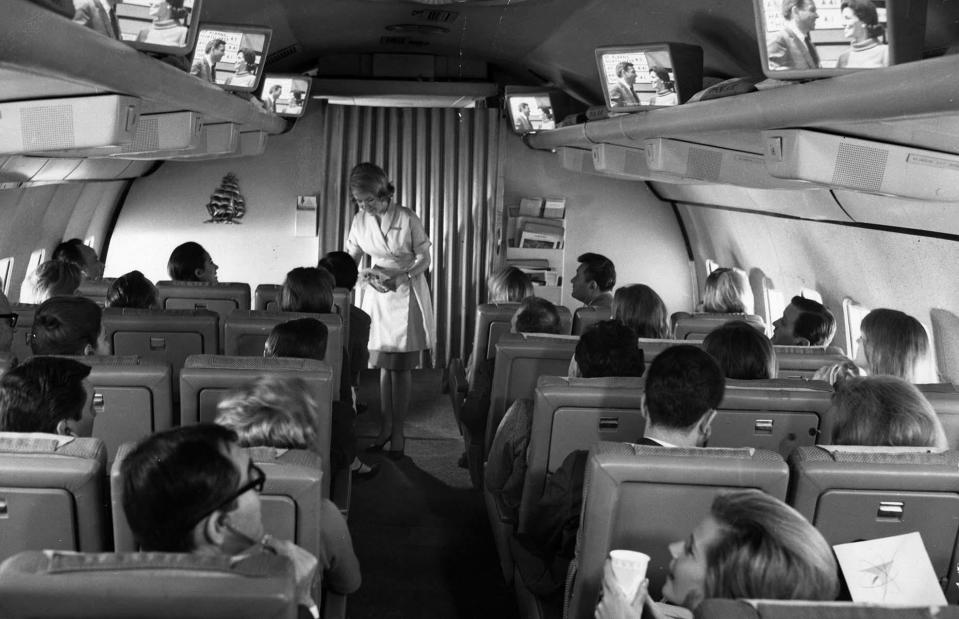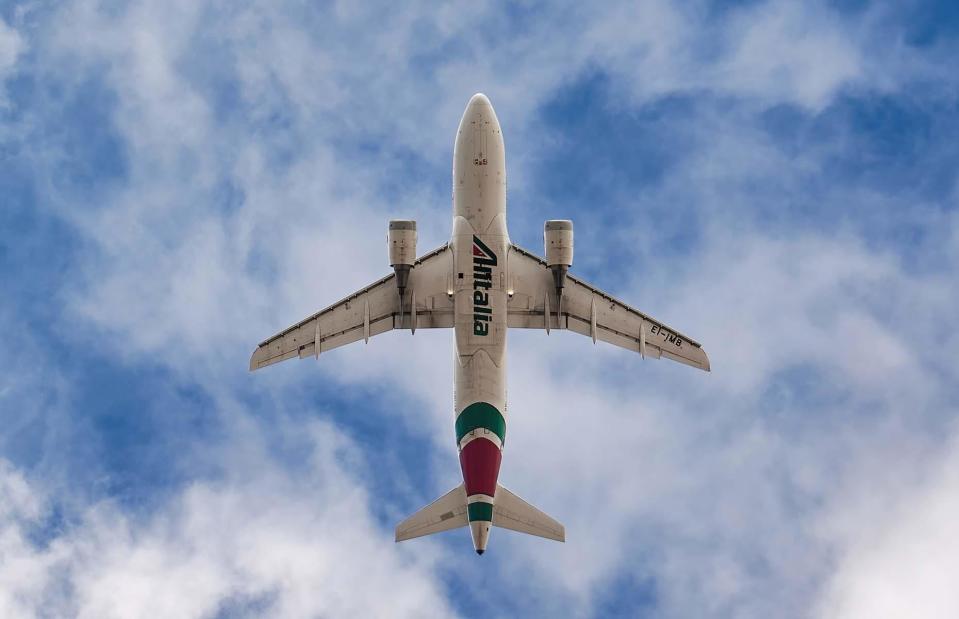How many of these forgotten airlines do you remember?
The big names that once dominated the skies

KRAIPIT PHANVUT/AFP via Getty Images
It can be down to bankruptcy, mergers or marketing mistakes, but even the biggest businesses can go bust and the airline industry is no exception to this rule.
From Pan Am to Alitalia, read on for the fascinating stories behind some of the most well-known airlines that no longer exist and why they had to fold their wings for good.
Laker Airways, 1966-1982

John Williams/Evening Standard/Getty Images
Originally a charter airline, Laker Airways became one of the first no-frills airlines of its kind, founded in 1966 by British entrepreneur Sir Freddie Laker (pictured). The private enterprise pioneered clever cost-saving tricks, such as the reduced thrust take-off technique and weight-saving measures. This led Laker to become the sun seeker's favorite carrier, thanks to its pocket-friendly fares to vacation resorts in the Mediterranean and the Canary Islands.
Laker Airways, 1966-1982

Evening Standard/Hulton Archive/Getty Images
Keen to expand further, Laker launched new successful ventures such as transatlantic flights that provided meals, movies and a free bar. In 1971, Sir Freddie announced the Skytrain, a low-cost summertime, transatlantic service between London and New York. The first flight didn't take off until 1977, but by 1981 the Skytrain was also flying to Los Angeles, Miami and Tampa.
Laker Airways, 1966-1982

Aviation History Collection/Alamy Stock Photo
Unfortunately, Laker Airways didn't have the financial strength to survive the 1980s recession and couldn't keep up with other established big-name airlines. The beginning of the end came when rivals Pan Am dropped its transatlantic economy fares to compete. Laker collapsed in 1982 and its owner sued a number of high-end airlines for conspiracy to put his airline out of business, all of which settled out of court.
Pan Am, 1927-1991

Hulton Archive/Stringer via Getty Images
Pan Am, or Pan American World Airways, is probably one of the most well-known airlines to ever exist and shut down. A true rags-to-riches of the skies story, this humble airmail and passenger carrier started shuttles from Key West in Florida to Havana, Cuba in 1927 and grew into a revolutionary international success that pioneered numerous industry innovations, from jet aircraft to computerised booking systems. The airline started operating South American and transatlantic routes on flying boats from the 1930s and by the mid-20th century had a near monopoly on international routes.
Pan Am, 1927-1991

Underwood Archives/Getty Images
The airline acquired new jetliners, like the Boeing 707 and Boeing 747, thus thrusting the industry into the Jet Age with its first daily service from New York to Paris. This, along with Pan Am's impeccably well-trained staff, gave the company a glamorous reputation. In 1970 alone, the airline transported 11 million passengers. On 21 January 1970, Pan Am was the first to use the Boeing 747 – aka the Jumbo Jet – starting service on the airline's New York to London route.
Pan Am, 1927-1991

KRAIPIT PHANVUT/AFP via Getty Images
After Pan Am's founder Juan Trippe died in 1981, its supremacy began to wane. Oil crises and stiff competition also had knock-on effects. The tragedy of Pan Am Flight 103 from London to New York in 1988 was probably Pan Am's final devastating blow. The aircraft was blown up over Scotland and crashed into the town of Lockerbie, killing all on board, plus 11 on the ground. The airline ceased operations in 1991.
Trump Shuttle, 1989-1992

Walter McBride/MediaPunch/Alamy Stock Photo
The former US President Donald Trump stepped into the airline business when he purchased landing rights and physical assets from an arm of Eastern Air Lines in the late 1980s. The new operation launched in 1989 and Trump's plan was to convert it from its previous position as a no-frills airline for business travelers to a luxury service. On board, passengers could expect free meals, including steak on some flights, as well as complimentary Champagne, beer and wine.
Trump Shuttle, 1989-1992

Aero Icarus/Flickr/CC BY-SA 2.0
Perhaps the airline's downfall was Trump's vision to make it uber luxurious: he installed maple wood veneer, chrome seat belt latches and gold-coloured lavatory fixtures in his aircraft. Or, maybe it was the recession. Fuel-price hikes and personal bankruptcy, as well a decline in sales when passengers switched to Pan Am, led Trump to merge the venture with US Airways in 1992, after only three years in the air.
Trans World Airlines, 1930-2001

JT Vintage/Zuma Press/PA Images
Trans World Airlines (TWA) was formed in the United States in 1930, but grew to be the second unofficial flag carrier of the US, after millionaire Howard Hughes became the company's main shareholder in 1939. During his ownership, Hughes successfully grew TWA into one of America's most well-known brands. It maintained extensive routes in the United States, as well as connections to Europe, the Caribbean and the Middle East. Also, thanks to Hughes' Hollywood connections, TWA gained a glamorous reputation at the height of the Jet Set era, and the company gained many loyal movie star passengers.
Trans World Airlines, 1930-2001

Alan Band/Keystone/Getty Images
Hughes lost control of the airline to a group of Wall Street banks in 1961, which led to him selling his shares in 1966. A succession of hijacking and terrorism scares contributed towards TWA's demise too. In 1985, TWA Flight 847 was en route from Cairo to San Diego when the plane was hijacked after a stop in Athens and in 1996, TWA Flight 800 exploded mid-air due to an alleged technical issue. Eventually TWA's assets were acquired by American Airlines in 2001 and the airline ceased to exist.
Trans World Airlines, 1930-2001

JT Vintage/Zuma Press/PA Images
During its peak in the 1960s, TWA opened the Trans World Flight Center (pictured) at New York City's JFK Airport. The impressive building was a cutting-edge terminal designed by Finnish-American architect Eero Saarinen, who's known for his futuristic style. Although the iconic, gull wing-shaped terminal sat empty after TWA was acquired, the landmark building has been brought back to its former glory as the TWA Hotel, complete with vintage TWA aircraft "Connie", who has been lovingly repurposed into a unique cocktail lounge.
Britannia Airways, 1961-2005

ERIK STRODL/Alamy Stock Photo
British airline Britannia Airways was founded in 1961 by British businessman Ted Langton as Euravia and soon became known as the world's largest vacation airline. It rebranded to Britannia Airways in 1964 and by 1972, it was the largest British independent charter airline, concentrating mainly on Spanish tourist destinations. In the 1980s, the airline's fleet grew to include nearly 30 Boeing 737s and it was also the first European airline to fly the Boeing 767, which helped the airline expand to more long-haul destinations.
Britannia Airways, 1961-2005

Rob Hodgkins/Flickr/CC BY-SA 2.0
In 1965, Britannia became part of the Thomson Travel Group yet retained its independence, name, logo and livery for the following 35 years. Then in 2000, Thomson Travel Group was acquired by German company TUI Group and by 2005, Britannia was rebranded to Thomsonfly. Although Britannia proper ceased to exist in 2005, remnants of the airline are part of TUI, a current British charter airline.
Continental Airlines, 1934-2010

James Leynse/Corbis via Getty Images
Continental Airlines started life as a humble mail carrier called Varney Speed Lines, founded by Walter Varney in 1934. In the following decades, it expanded rapidly, acquiring Pioneer Airlines in the 1960s. Continental became an airline that led the way and was the first major US carrier to hire an African-American pilot in 1963. It also established many new long-haul jet routes. In the early 1980s, deregulation hurt the airline as passengers chose low cost over better service and eventually it declared bankruptcy. Surprisingly, that wasn't the end of it.
Continental Airlines, 1934-2010

TRISTAR PHOTOS/Alamy Stock Photo
Continental managed to bounce back with a reorganization and the appointment of former Boeing executive Gordon Bethune in 1994 changed the airline's fortunes. Bethune turned the airline from "worst to first", as he describes in great detail in his book of the same name. The airline became one of the most respected brands and was one of the last US airlines to still offer free pillows, blankets and meals on domestic flights. Bethune also helped raise Newark Airport's profile to successfully rival New York's JFK.
Continental Airlines, 1934-2010

IanC66/Shutterstock
Bethune left the company in 2004 and the airline was greatly affected by the 2008 financial crisis. As a result, Continental cut 3,000 jobs, reduced salaries and also capacity, and merger talks with United Airlines Holdings, operator of United Airlines, began. The merger was completed in 2010 and United completely absorbed Continental, bar one small detail – the new livery design retained Continental's iconic globe on the aircraft's tail.
US Airways, 1937-2015

Universal Images Group North America LLC/Alamy Stock Photo
US Airways was launched as All American Aviation, Inc. in 1937 and started life as a mail carrier across the mountainous regions of Pennsylvania and West Virginia. Passenger services started in 1949 and with a new name, Allegheny Airlines, the airline focused predominantly on routes connecting the Midwest to the Atlantic coast. Over the following decades, the airline took over several smaller carriers and expanded its network to 193 destinations in 24 countries at its peak.
US Airways, 1937-2015

TOM MIHALEK/AFP via Getty Images
During its most successful period in the 1990s, the airline (called USAir at the time) entered into a brief transatlantic alliance with British Airways – it was renamed US Airways in a bid to develop a more international image. In 1997, the airline acquired the remains of the former Trump Shuttle and launched its own shuttle service alongside a new MetroJet service, intended to compete with Southwest and Delta Express in the West and AirTran in the South. However, the new decade arrived, delivering one blow after another.
US Airways, 1937-2015

PASCAL PAVANI/AFP via Getty Images
In the aftermath of 9/11, US Airways lost a lot of revenue due to the temporary closure of Washington DC's Ronald Reagan Airport, which took away a significant portion of its network. The airline dehubbed its Washington operations and filed for bankruptcy in 2002. Another blow came when the airline was forced to leave its hub in Pittsburgh and relocate to Philadelphia and Charlotte. During the Christmas holiday rush in 2004, the company came close to liquidation, as most disgruntled employees opted to call in sick. Surprisingly, the airline survived and was briefly revived after it merged with America West Airlines.
US Airways, 1937-2015

Greg Lam Pak Ng/Flickr/CC BY 2.0
The airline dominated headlines around the world due to the 'Miracle on the Hudson', when Captain Chesley 'Sully' Sullenberger famously landed an Airbus A320 on the Hudson River after a bird strike and saved everyone on board. However, the airline would soon be acquired by American Airlines. US Airways completed its final flight in October 2015, when the merger was finalised, and the last remaining US Airways liveries were repainted in 2016.
Monarch Airlines, 1967-2017

Mike Freer - Touchdown-aviation/Wikimedia/GFDL-1.2
Founded in 1967, this British airline was aimed at families looking to escape to sunnier shores. At its peak in the 1980s, the budget airline flew two million vacationers mostly around Europe. It was also the first airline to fly a UK-operated twin-engine jet over the Atlantic Ocean, when it transported its 235 passengers from Luton Airport to Orlando in Florida, USA in 1988.
Monarch Airlines, 1967-2017

Santi Rodriguez/Shutterstock
However, financial difficulties plagued the airline since the start of the new millennium. Then, the EU referendum in the UK, and the associated fall in the British pound against the US dollar, left the already struggling Monarch paying millions more for fuel. An order for Boeing 737 Max planes, worth around $3 billion, was also due to be charged in US dollars. Despite receiving a rescue package in 2011, and later scoring investment from Boeing in 2016, Monarch Airlines grounded all flights in 2017 after nearly 50 years of service. It went into administration, leaving 110,000 passengers stranded abroad.
Air Berlin, 1978-2017

JOHN MACDOUGALL/AFP via Getty Images
First registered as an American company in 1978, Air Berlin grew to become the second-largest airline in Germany after Lufthansa. Being American, it was allowed to fly in and out of West Berlin, which could not be served by airlines operating in East Berlin, like Lufthansa. The fall of the Berlin Wall in 1989 and German reunification saw the airline rapidly expand.
Air Berlin, 1978-2017

Nordroden/Shutterstock
In 2006, Air Berlin floated on the stock exchange but was forced to lower the price of the shares almost immediately. It had also based a lot of its future plans on a new hub at the new Brandenburg Airport in Berlin, which was due to open in 2011, but suffered delays for almost a decade. Then in 2011 Etihad propped up the business by becoming its main shareholder. The airline continued to struggle to compete with low-cost airlines like Ryanair and easyJet, and in October 2017 the company filed for bankruptcy.
Air Berlin, 1978-2017

MARCEL KUSCH/AFP/Getty Images
German air giants Lufthansa purchased a number of aircraft and employed former Air Berlin employees, while easyJet took on operations at Berlin Tegel Airport. In January 2018, auction house Dechow ran a sale of all Air Berlin assets including seats, model planes and even branded chocolates in a bid to raise cash to clear its $935 million debt.
Primera Air, 2003-2018

David Herraez Calzada/Shutterstock
This Danish airline had mainly carried Scandinavians around the globe for 17 years before its demise. Founded in 2003 as JetX, it became Primera Air in 2009. At its peak in 2014, the company flew 155,000 passenger on 1,006 flights in the space of a year and after a run of successful short-haul expansions, the airline was ready to try out a new venture...
Primera Air, 2003-2018

Primera Air/Twitter
Primera Air announced plans for low-cost transatlantic travel from London to New York, Boston, Toronto and Washington DC at the beginning of 2018. It splashed out on marketing which – coupled with repair expenses, late delivery of new planes and inefficient older stock – led to the airline's downfall. Planes were in the air and passengers were lining up to board flights when the closure was announced. Consequently, many angry passengers and crew were left stranded in both Europe and America.
Virgin America, 2007-2018

Justin Sullivan/Getty Images
While Virgin Atlantic still takes to the skies, the same can't be said about one of its sister airlines, Virgin America. Founded in 2007 as an independent airline with Virgin licensing, it focused on low-cost travel mainly on the US West Coast.
Virgin America, 2007-2018

Bob Riha Jr./WireImage via Getty Images
Sir Richard Branson was keen to give his new venture the same glamorous appeal as his other companies: staff wore the famous red uniforms, funky mood lighting graced the cabins, glitzy parties were held to celebrate new routes and the airline grew an impressive celebrity passenger following. It was also the first airline to offer free in-flight wi-fi access to all customers.
Virgin America, 2007-2018

Aerial Archives/Alamy Stock Photo
It wasn't as much a failure as a money-making sale that put an end to Virgin America. After being approached by several airlines interested in a takeover, Virgin America was acquired by Alaska Airlines for a purchase price of £$2.6 billion in 2016. They slowly retired the brand, painting over the fleet livery with their logo and colours. Sir Richard Branson expressed his sadness with an open letter published on his Virgin blog titled Dear Virgin America.
Alitalia, 1947-2021

RuthAS/Wikimedia/CC BY 3.0
Once the flag carrier and the largest airline of Italy, Alitalia began operations in 1947 with an inaugural flight from Turin to Catania via Rome. The first intercontinental operations started just a year later, connecting Milan and cities in South America. The airline was also an early adopter of jet airliners, like the Sud Caravelle and the Douglas DC-8 on some of its long-distance routes. By the 1990s, Alitalia was carrying 25 million passengers annually, but the new century brought about the first financial troubles.
Alitalia, 1947-2021

BlackFarm/Shutterstock
The airline went bankrupt in 2008 and it was acquired by a group of investors who formed Compagnia Aerea Italiana (CAI). Alitalia was relaunched in 2009 and 25% of the company's shares were sold to Air France-KLM. Controversially, the 'new' Alitalia didn't claim the history as its own and insisted on being a brand new company, thus not recognising previous Alitalia passenger benefits or honoring old passenger claims. After further investor troubles, the Italian government took over in 2020, but to no avail. The company ceased operations in August 2021 and flew its last service in October that year.
Now find out where cruise ships, planes, trains and automobiles go to die


